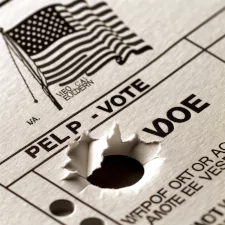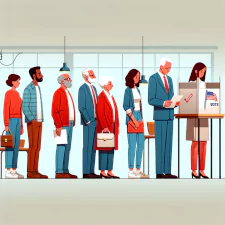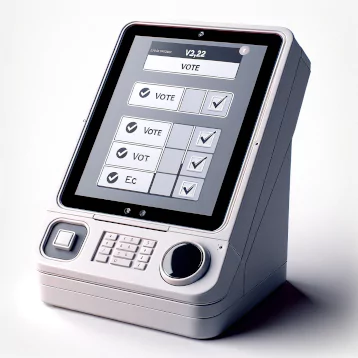Floridas Hanging Chads
Imagine, if you will, the United States embroiled in one of the most controversial presidential elections: The year was 2000, and chaos reigned supreme. Enter from stage left – The Help America Vote Act (HAVA) of 2002.
Key Takeaways
- Modernization: HAVA modernized voting equipment and registration systems, addressing outdated methods exposed in the 2000 election.
- Accessibility: The Act enhanced voting accessibility for individuals with disabilities, ensuring inclusive participation.
- Reliability: HAVA established minimum standards and provisional voting to improve the reliability and integrity of elections.
Table of Contents
- What is The Help America Vote Act of 2002
- Aiming for Utopia or Just Damage Control?
- The Drama that Led to HAVA
- Hanging Chads And Butterflies
- Upgrading the Voting System
- The bipartisan fervor was ignited to ensure another 'Florida' never happened again. The result?
- Main Features of HAVA: "The Nitty-Gritty of the Act"
- Provision for New Voting Systems: "Kicking Out Old School Methods"
- Voter Registration Modernization: "No More Paper Trails"
- Provision for Disabled Voters: "Ensuring No Voter is Left Behind"
- Impact on State and Local Governments: "Ripples Across the Pond"
- Financial Implications: "Funding the Future of Voting"
- Administrative Changes Required: "Red Tape and New Rules"
- Tech Woes in Democracy: Concerns Over Electronic Voting Systems
- The ID Dilemma: Issues with Voter Identification Requirements
- Amendments to HAVA the Evolution of an Act
- Military and Overseas Voter Empowerment Act: “Democracy Beyond Borders”
- Spreading Wings: Democracy Finds Its Global Footprint
- Conclusion: “HAVA’s Legacy – Revolutionizing American Democracy”
- The Age Of Electronic Voting: A Brave New World
- Empowering Every Citizen: No Voter Left Behind
- Appendix (Optional): "Nerd Alert! Delving Deeper into Legal Jargon"
- Lost in Translation: Decoding Legal Speak
- A New Electoral Era: The Help America Vote Act of 2002
- Frequently Asked Questions:
What is The Help America Vote Act of 2002
The Help America Vote Act of 2002 (HAVA) is a United States federal law enacted in response to the voting issues that were highlighted during the 2000 presidential election. Signed into law by President George W. Bush on October 29, 2002, HAVA was designed to improve the administration of elections in the U.S.
Overall, HAVA represented a significant federal effort to reform voting processes, increase accessibility and reliability in voting systems, and restore public confidence in the electoral process.
Aiming for Utopia or Just Damage Control?
Now you might ask, “Was HAVA a desperate bid to attain electoral utopia or merely damage control?” The truth probably lies somewhere in between. HAVA was both aspirational and pragmatic — it sought to enhance the:
- Accessibility
- Integrity
- Reliability
- Voting procedures
While also addressing immediate concerns from that infamous 2000 election debacle between Al Gore and George W. Bush. This act also showcased federalism at work – demonstrating how a national crisis could spawn state-level innovation while simultaneously seeking compliance with federally established standards.
Call it a balancing act or call it wisdom derived from democratic growing pains — either way, HAVA was transformative. So buckle up my friend!
We’re about to embark on a journey through time as we dissect this influential piece of legislation — exploring its origins, main features, impact on state and local governments, lingering controversies surrounding it, and its subsequent amendments. Strap in and let’s uncover the layers of HAVA, a truly revolutionary piece of legislation in America’s vibrant democracy.
The Drama that Led to HAVA
Let’s cast our minds back to the year 2000. It was the time when Y2K fears had barely subsided, and NSYNC was taking over the airways. But in a far less fun corner of history, we were grappling with one of the most problematic presidential elections in modern American history.
Hanging Chads And Butterflies

I’m not talking about an episode from ‘House of Cards’, folks! The 2000 election debacle was as real as it gets. As George W. Bush and Al Gore danced their political tango, voters battled hanging chads (partially detached bits of paper on punch card ballots) and butterfly ballots (strangely designed voting papers).
The drama unfolded like a nail-biting thriller, culminating in a controversial Supreme Court decision favoring Bush. The chaos revealed deep flaws in our voting system—flaws that could no longer be ignored.
Take Florida, for instance: butterfly ballot confusion led elderly Palm Beach County voters to accidentally vote for third-party candidate Pat Buchanan instead of Al Gore due to poor layout design. Then there were the infamous hanging chads that turned vote counting into an art form that required light sources and keen eyesight to determine voter intent—far from ideal!
Upgrading the Voting System
Dubbed “the election that would not end”, 2000 brought vividly into focus just how outdated parts of America’s voting infrastructure had become. Overhauls were needed across a wide array of areas—from archaic and unreliable voting machines plagued by mechanical errors to confusing ballot design leading to some votes being misinterpreted or worse; lost entirely. But perhaps one key message stood out above all else—change was needed…and fast!
After witnessing firsthand just how muddled things could get, it became clear to both lawmakers and the general public that voting, the very bedrock of our democracy, needed a substantial upgrade. And so, the wheels began to turn.
The bipartisan fervor was ignited to ensure another ‘Florida’ never happened again. The result?
Drumroll, please…The Help America Vote Act of 2002 (HAVA). A hopeful step into the future, HAVA was intended to be the silver bullet that would finally drag American voting mechanics, kicking and screaming if necessary, into the 21st century.
The “Help America Vote Act” (HAVA) of 2002
Was a bipartisan effort in the United States Congress.
The key sponsors of the bill were:
Senator Christopher Dodd (D-CT):

Senator Christopher J. Dodd served for thirty years in the United States Senate and six years in the United States House of Representatives, representing the people of Connecticut.
He was one of the primary authors of the Act, serving as a Democrat from Connecticut.
Representative Bob Ney (R-OH):

Ney pleaded guilty on October 13, 2006, to two-counts. charged with conspiracy to commit multiple offenses. He was sentenced to 30 months in prison for corruption crimes.
As a Republican member of the House from Ohio, Ney co-sponsored the legislation in the House of Representatives. Ney was a Congressman representing the 18th District of Ohio from 1995 through the present. In 2001, Ney became chairman of the House Committee on Administration, a position he held until January 2006.
Main Features of HAVA: “The Nitty-Gritty of the Act”
Indeed, the Help America Vote Act (HAVA) came bearing multiple gifts. This legislation was not a bland, monotonous legal document.
Instead, it was a Pandora’s box filled with reforms that would change the face of American democracy. Firstly, HAVA put robust measures in place to ensure that voting systems were up-to-date and functioning optimally.
Next on its agenda were significant changes to voter registration procedures to enhance efficiency and security. Last but certainly not least, the legislation ensured that disabled voters received particular attention.
Provision for New Voting Systems: “Kicking Out Old School Methods”
Remember those antiquated lever machines or punch card voting systems? Well, HAVA essentially showed them the door. Punch cards became historical artifacts overnight as HAVA provided funding for states to replace these outdated technologies with modern voting equipment.
Technology buffs relished this move towards electronic voting systems (EVS). These advanced systems offered advantages like instant vote tallying and fewer user errors compared to traditional alternatives.
However, they also carried concerns about security and reliability – but we’ll delve into that later. Despite these concerns, it was clear HAVA had set out on a mission – to drag American elections from yesteryears’ cumbrous methods into today’s digital age.
Voter Registration Modernization: “No More Paper Trails”

If you thought bidding goodbye to punch cards was dramatic enough, hold onto your hats because there’s more! Another key feature of HAVA was its effort to modernize voter registration by creating statewide computerized voter registration lists. This monumental shift aimed at doing away with cumbersome paperwork while facilitating easier management and verification of registered voters.
Imagine being able to update or check your voter status in real time without shuffling through stacks of paper! Even though the transition wasn’t without hiccups (and several raised eyebrows), it represented a significant leap in how American voters interacted with the electoral process.
Provision for Disabled Voters: “Ensuring No Voter is Left Behind”
For too long, disabled voters had been sidelined due to inaccessible voting systems. But HAVA insisted – not anymore!
Recognizing that disability should never be a barrier to exercising one’s right to vote, HAVA enforced provisions for accessible voting systems. These systems were designed with various disabilities in mind, ensuring that every voter, regardless of their physical abilities or challenges, could cast their vote privately and independently.
Talk about equality and inclusion! In addition to physically accessible voting machines, HAVA also made room for alternatives such as curbside voting – truly making sure no voter was left behind.
Impact on State and Local Governments: “Ripples Across the Pond”
The HAVA of 2002 wasn’t just a piece of federal legislation that impacted Washington insiders. Indeed, it sent ripples across the pond, initiating changes and causing waves in state and local governments across the nation. The implementation of this legislation mandated profound alterations to voting systems, administrative processes, and even financial structures at these levels.
As with any federal mandate, there was a trickle-down effect. It wasn’t just about changing machines or modernizing voter registration; it also involved an overhaul of rules, requirements, and regulations at every level of the electoral hierarchy.
Essentially, HAVA rocked the boat for everyone from the state governor’s office down to your local city clerk. The vote is considered sacred in our society; it’s democracy’s beating heart.
Therefore, altering voting systems can often feel like performing open-heart surgery on our democratic process – risky but fundamentally necessary for survival. Let’s dive deeper into how these ripples have manifested within state and local governments under two critical aspects: financial implications and required administrative changes.
Financial Implications: “Funding the Future of Voting”
Modernization isn’t cheap – especially when you’re dealing with something as vast as a country’s voting system. The transition from punch-card ballots to electronic voting systems was not only technically challenging but also financially burdensome for many states. To help alleviate this burden, HAVA provided a whopping $3 billion in federal funds to assist in implementing its numerous provisions.
These funds were used to replace outdated punch card and lever voting systems with more advanced optical scan or direct-recording electronic (DRE) machines. The act also assigned funding for voter education about these new systems and training for poll workers who would navigate this brave new world of digital democracy.
While HAVA did provide financial assistance, it was far from a free ride for states. The strings attached to these funds came in the form of required state matches and maintenance-of-effort requirements.
Essentially, this meant that states had to contribute financially and prove they were maintaining or improving their voting systems to continue receiving federal aid. This requirement sometimes strained already tight state budgets, as they attempted to keep pace with the rapidly evolving digital landscape.
Administrative Changes Required: “Red Tape and New Rules”
Beyond the financial implications, HAVA also necessitated an administrative overhaul. This included a myriad of new requirements – from establishing statewide voter registration databases and instituting voter identification procedures for first-time voters who register by mail, to providing provisional voting options for individuals whose eligibility is uncertain on Election Day.
The act also required that each polling place have at least one voting system accessible for persons with disabilities. States had to make considerable efforts to ensure compliance – painstakingly coordinating between various departments, training personnel, adapting infrastructure, and spreading awareness among citizens about these changes.
In addition to modifying existing practices, states also had to devise grievance redressal mechanisms for those who believed their rights under HAVA were violated. It was also mandated that each state establish a five-member State Election Board – thus adding another layer of bureaucracy but intending to ensure fair administration of elections.
Tech Woes in Democracy: Concerns Over Electronic Voting Systems
With HAVA’s introduction of electronic voting systems, one might expect the applause for technology embracing democracy. However, not all greeted this amalgamation with open arms. Detractors raised substantial concerns about the reliability and security of electronic systems.
The first bone of contention revolved around software glitches and hardware malfunctions. Critics voiced fears about the dismal implications if machines were to fail on election day – a scenario not outlandish given even our most advanced tech gadgets are prone to unpredictable hiccups.
They argued that such situations could lead to lost or miscounted votes, compromising the election’s integrity. Beyond these practical issues lurked a more menacing concern – cybersecurity threats.
In an era where hackers seem capable of breaching even high-security infrastructures, skeptics are worried about cyberattacks manipulating vote counts or disrupting elections altogether. Despite assurances from authorities about stringent security measures, these concerns continue to hover over American democracy like an ominous cloud.
The ID Dilemma: Issues with Voter Identification Requirements

The second major controversy associated with HAVA deals with voter identification requirements. While designed to prevent voter fraud by ensuring that each vote cast corresponds to a verified identity, this provision has stirred fierce debate.
Critics argue that such requirements disproportionately burden marginalized communities who might lack proper ID forms due to socioeconomic circumstances or bureaucratic obstacles. This argument frames the ID requirement as an inadvertent yet powerful tool for voter suppression.
Additionally, detractors contend that this measure is targeting a largely non-existent problem as incidents of in-person voter fraud are incredibly rare according to numerous studies. Despite these criticisms, advocates maintain that strict ID rules are vital for preserving electoral integrity – showcasing how underlying philosophies can shape our views on seemingly straightforward topics like voting procedures.
Amendments to HAVA the Evolution of an Act
The Help America Vote Act, like any robust piece of legislation, recognizes the necessity for evolution and adaptation in congruence with the shifting sands of our societal and technological landscape. Over the years, numerous amendments have been incorporated into HAVA, reflecting a steadfast commitment to honing our nation’s democratic processes.
For instance, in 2009 a significant amendment was made via the Military and Overseas Voter Empowerment Act (MOVE). This act sought to address some of the unique challenges faced by military personnel stationed overseas and other citizens living abroad who wished to participate in their civic duty.
Military and Overseas Voter Empowerment Act: “Democracy Beyond Borders”
The Military and Overseas Voter Empowerment Act emanated from an earnest endeavor to enfranchise those protecting our nation’s interests beyond its borders. Before its enactment, overseas military personnel faced numerous obstacles when attempting to vote.
The labyrinthine process was fraught with late ballots, inadequate preparation time due to mail delays, plus convoluted registration procedures. Recognizing this inequity as a disservice to those in uniform, MOVE aimed at rectifying these issues by providing key changes in how absentee ballots were handled.
The results? A more streamlined voting process that respects the rights of these vital members of our democracy.
Spreading Wings: Democracy Finds Its Global Footprint
But MOVE didn’t stop at just aiding soldiers – it also extended its reach to American civilians residing overseas. A shift towards electronic transmission methods marked a groundbreaking departure from traditional snail mail procedures that had long been a roadblock for international voters.
In essence, these amendments breathed new life into HAVA’s core ethos – making voting accessible to all American citizens, irrespective of where they may be. Indeed, it is through such relentless refining that our democracy continues to mature, ensuring every voice is heard, valued, and counted.
Conclusion: “HAVA’s Legacy – Revolutionizing American Democracy”
The Help America Vote Act of 2002 or HAVA, despite its occasional tribulations, has undeniably brought about a monumental shift in the landscape of American elections. It’s often said that the greatness of a democracy lies in the hands of its voters.
HAVA took this to heart and sought to empower every voter by modernizing an age-old system fraught with imperfections. In essence, what HAVA achieved was to bring voting out from under the shadows of antiquated processes and into the light of technology and accessibility.
It acknowledged the importance of every citizen’s right to vote – a right so pivotal that it warranted an overhaul of longstanding procedures. The act recognized both the strength and vulnerability inherent in this fundamental democratic process.
The Age Of Electronic Voting: A Brave New World
One cannot talk about HAVA without mentioning electronic voting systems – machines that were as groundbreaking then as they are contentious now. These novel devices were deployed with great fanfare across polling stations, replacing punch card systems that had become synonymous with confusion and errors. However, like any avant-garde technology, these systems faced their fair share of criticisms and skepticism.
Concerns were raised over their robustness against potential manipulation or malfunctions. Despite these challenges, one must remember that these issues are not intrinsic defects but rather areas for improvement in an otherwise transformative solution.
Empowering Every Citizen: No Voter Left Behind
The intention behind HAVA was noble – it sought not just to improve efficiency but also inclusivity. For too long, disabled citizens had been inconvenienced by archaic voting procedures ill-equipped for their needs. Under HAVA’s provisions, every polling station was made more accessible, with specialized equipment installed to aid those with disabilities.
This was a landmark move, signaling that when it came to voting, every voice mattered. The echoes of this act continue to reverberate in today’s inclusive society.
HAVA might not be without its issues, but despite everything, it stands as a testament to America’s unwavering commitment to upholding the sanctity of its democratic process. Its legacy lies in revolutionizing American democracy by ensuring that the power truly remains with the people.
Appendix (Optional): “Nerd Alert! Delving Deeper into Legal Jargon”
For those of us who revel in the labyrinthine trenches of legal language and legislative lingo, there’s a veritable goldmine to be unearthed within the Help America Vote Act. Strap on your miner’s lamp, my friend, and let’s dig deep into the subterranean depths of this monumental law’s nitty-gritty. In essence, HAVA was designed to reform multiple aspects of existing voting procedures.
One such facet included replacing punch card voting systems with new technology that promised foolproof vote counts. Such an idea was groundbreaking; after all, this was at a time when tech revolutions were still budding.
The precise legislative language reads: “Make payments to states for replacement of punch card or lever voting machines.” It then goes on to detail the regulations surrounding these payments. The act wasn’t only focused on technology upgrades though; it also aimed to provide “Assistance for voters who have language limitations or disabilities.” This section painstakingly outlines the steps necessary to ensure that every citizen can afford their fundamental right – accessible and independent voting.
A Walk Through Legislative Labyrinth
Moving further down through the rabbit hole, we stumble upon Title III of HAVA which meticulously expounds upon ‘Uniform and Nondiscriminatory Election Technology and Administration Requirements.’ Now clutch your virtual law glossary tight as this passage is laden with stringent stipulations designed to standardize election procedures across states. One intriguing section here concerns provisional voting. Painted in broad strokes, it articulates that voters whose eligibility is in question should not be denied their right to vote; instead, they’re given a provisional ballot – a sort of ‘vote now, verify later’ system.
Trust me when I say that understanding such prescriptions can be as exciting as deciphering Da Vinci’s code! And finally, the HAVA is also armed with provisions for audit and grievance redressal mechanisms.
These are systematic fail-safes against any potential breach of voting rights or law violations. As they say in legal circles, it’s like a safety net woven with the threads of justice.
Lost in Translation: Decoding Legal Speak
The real lingua franca of HAVA can be traced through its definitions section: Title IX – Miscellaneous Provisions. Here lies the Rosetta Stone to understand concepts such as ‘uniform definition of voter registration’ and ‘maintenance of effort.‘ If you’re scratching your head, welcome to the club! These highfalutin terms simply signify standardizing the voter registration process and ensuring continued efforts in maintaining voting systems respectively.
All said and done, unearthing the hidden gems within the cavernous legal speak can be a Herculean task yet simultaneously provides an intellectual high that only legislation lovers could relate to. The Help America Vote Act is indeed a Pandora’s box filled with fascinating articulations waiting to be interpreted.
And thus, dear reader, we conclude our venture into this labyrinthian world of legislation. As captivating as its depth might have been, remember not to get lost in it – after all, we still have an actual world waiting for us on the surface!
A New Electoral Era: The Help America Vote Act of 2002
Frequently Asked Questions:
What is the Help America Vote Act of 2002?
The Help America Vote Act (HAVA) of 2002 is a federal law designed to improve the administration of elections in the U.S., particularly in response to the issues highlighted during the 2000 presidential election.
Why was HAVA enacted?
HAVA was enacted to address voting problems revealed in the 2000 presidential election, such as outdated voting systems and confusing ballot designs, and to restore public confidence in the electoral process.
What are the key provisions of HAVA?
Key provisions of HAVA include funding for modernizing voting equipment, establishing minimum standards for election administration, ensuring accessibility for disabled voters, and requiring provisional voting and voter identification for first-time voters who register by mail.
How does HAVA improve accessibility for disabled voters?
HAVA mandates that voting systems be accessible to individuals with disabilities, allowing them to vote privately and independently. It also includes provisions for curbside voting and other accommodations.
What is the role of the Election Assistance Commission (EAC) under HAVA?
The EAC was established by HAVA to assist with the administration of federal elections, provide guidance on election reform, and ensure compliance with the Act’s requirements.

Just wanna comment that you have a very decent internet site, I enjoy the design it really stands out.